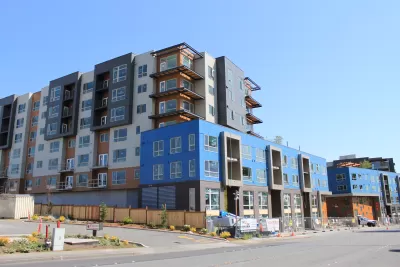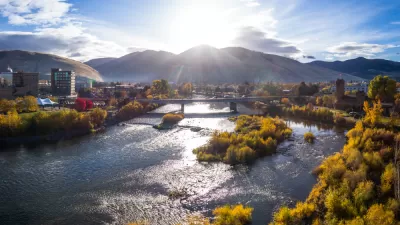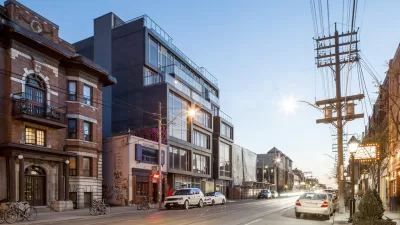Last week's urbanism social media landscape was dominated by discussion of an article that digs into the historical and technical origins of the contemporary mid-rise apartment building type.

Justin Fox writes on a controversial topic familiar to planners—the general uniformity of new buildings around the United States.
These buildings are in almost every U.S. city. They range from three to seven stories tall and can stretch for blocks. They’re usually full of rental apartments, but they can also house college dorms, condominiums, hotels, or assisted-living facilities. Close to city centers, they tend toward a blocky, often colorful modernism; out in the suburbs, their architecture is more likely to feature peaked roofs and historical motifs. Their outer walls are covered with fiber cement, metal, stucco, or bricks.
Fox also fins evidence that mid-rise buildings are being built in greater numbers than ever—or at least since the Census Bureau started keeping track in 1972.
The conversation about the aesthetic characteristics of contemporary architectural styles (the kind built at large scale in cities all over the country, and not the signature pieces by international starchitects) is a familiar one. Patrick Sisson wrote on the subject most recently in December 2018, identifying a name for the style, "Fast-casual architecture," and connecting contemporary style to the contemporary housing crisis.
Fox digs into the stick construction techniques that these buildings have in common—wood framing that can save massive amounts of money for developers compared to concrete, steel, or masonry. Fox also traces the origins of the wood-framed building as the status quo of American apartment construction to the Uniform Building Code, first issued in 1927. Far from a damning critique, Fox points out the positives of wood construction before also mentioning the fire danger presented by these buildings before fire and life systems are added.
FULL STORY: Why America’s New Apartment Buildings All Look the Same

Planetizen Federal Action Tracker
A weekly monitor of how Trump’s orders and actions are impacting planners and planning in America.

Maui's Vacation Rental Debate Turns Ugly
Verbal attacks, misinformation campaigns and fistfights plague a high-stakes debate to convert thousands of vacation rentals into long-term housing.

Restaurant Patios Were a Pandemic Win — Why Were They so Hard to Keep?
Social distancing requirements and changes in travel patterns prompted cities to pilot new uses for street and sidewalk space. Then it got complicated.

In California Battle of Housing vs. Environment, Housing Just Won
A new state law significantly limits the power of CEQA, an environmental review law that served as a powerful tool for blocking new development.

Boulder Eliminates Parking Minimums Citywide
Officials estimate the cost of building a single underground parking space at up to $100,000.

Orange County, Florida Adopts Largest US “Sprawl Repair” Code
The ‘Orange Code’ seeks to rectify decades of sprawl-inducing, car-oriented development.
Urban Design for Planners 1: Software Tools
This six-course series explores essential urban design concepts using open source software and equips planners with the tools they need to participate fully in the urban design process.
Planning for Universal Design
Learn the tools for implementing Universal Design in planning regulations.
Heyer Gruel & Associates PA
JM Goldson LLC
Custer County Colorado
City of Camden Redevelopment Agency
City of Astoria
Transportation Research & Education Center (TREC) at Portland State University
Jefferson Parish Government
Camden Redevelopment Agency
City of Claremont





























